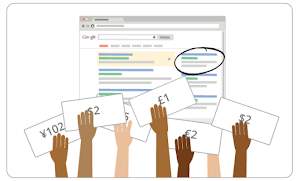Once you decide which networks you want to show your ads on and who you want to show them to, you're ready to think about your budget. As you learned in a previous module, there are two things that you'll want to consider:
- Your budget
- Your bidding strategy
Your budget
Your daily budget is the amount that you set for each campaign to indicate how much, on average, you're willing to spend per day.
 |
New AdWords advertisers might want to start small — between $5 and $50, for example — and then run their campaign for a few weeks before re-evaluating. You should choose a daily budget for each campaign based on your advertising goals and the general amount you're comfortable with spending each day.
If you're used to working with a monthly advertising budget, you can calculate the average amount you might budget per day by dividing your monthly budget by 30.4 (the average number of days per month).
|
Here are a few things to keep in mind about your budget:
- In general, the AdWords system will aim to show your ads as much as possible until your daily budget is met. Because customer traffic fluctuates from day to day, AdWords can allow up to 20% more clicks in a day than your budget specifies. However, our system makes sure that in a given billing period, you're never charged more than the monthly charging limit — 30.4 multiplied by your average daily budget amount.
- When your average daily budget is reached, your ads will typically stop showing for that day. You'll want to consider your campaign's ad delivery method, which determines how quickly your ads are shown and how long your budget lasts during a given day, when setting your daily budget. The "Standard" delivery method is like a slow-burning candle – it spreads your budget throughout the day. The "Accelerated" delivery method is more like jet fuel – it uses your budget more quickly.
Your bidding strategy
As you learned in a previous module, AdWords offers several bid strategies that are tailored to different types of campaigns. Depending on which networks your campaign is targeting, and your advertising goals, you can determine which strategy is best for you.
 |
To refresh your memory, here are the bid strategies you can choose from:
- Cost-per-click (CPC) bidding: Use if you want to drive customers to your website.
- Cost-per-impression (CPM) bidding: Use if you want to make sure that customers see your message.
- Cost-per-acquisition (CPA) bidding: Use if you want to maximize conversions on your website.
|
You can also use more advanced strategies like bid adjustments to bid more or less competitively across devices, locations, time of day, and more, or flexible bid strategies to automatically set bids to optimize for your performance goals.
In general, the higher your bid and the more relevant your ads and keywords, the more likely your ad will show at a higher position on the page. By managing your bids, you can influence the amount of traffic your ads receive.
CPC bidding
With CPC bidding, you can set a maximum amount that you're willing to pay for a click on your ad — this is a maximum cost-per-click bid, or simply "max. CPC." This bidding method can be a good value because you pay only when a viewer is interested enough to click your ad and learn more.
If you use CPC bidding, you'll have the option to use manual bidding and choose your own bid amounts or automatic bidding and let AdWords set your max. CPC bid for you to get as many clicks as possible given your overall budget.
Manual bidding gives you more control over your bids — for example, you can set different bids for individual keywords or Display Network targeting methods. With automatic bidding, you don't have to spend a lot of time setting and managing your bids.
When setting a max. CPC, you can figure out your bid amount based on what you know about your business and the value of a sale or customer lead. For example, if you sell US$5000 diamond rings, one new customer is probably worth more than if you sell US$0.99 packs of gum. You'll also want to use Keyword Planner to help you set CPC bids — the tool shows you how often some keywords get searched and gives you cost estimates at a glance.
CPM bidding
With CPM bidding, you bid for your ad based on how often it appears on the Display Network. Why use CPM bidding? If your advertising goal is to get your business' name in front of more people, for example, you might care more about ad impressions than clicks and visits to your website.
When you set a CPM bid, you set the maximum amount you're willing to pay per 1,000 ad impressions (we call this "max CPM").
One thing to keep in mind is that ads with different bid types can compete for the same Display Network placements. When CPC and CPM ads compete for the same placement, the two types of ads are compared apples-to-apples on how much they're effectively willing to pay for the impression. For a CPM ad, the max CPM bid represents how much the advertiser is willing to pay for each 1000 impressions; with a CPC ad, Google estimates how many clicks the ad might receive in 1000 impressions to get the comparison.
CPA bidding
CPA bidding is a bidding method that lets you tell AdWords the amount you're willing to pay for a conversion. It can help you reach customers who are likely to take action on your website.
To use CPA bidding, you'll need to either set up conversion tracking, cross-account conversion tracking, or be importing data from Google Analytics. You'll also need to turn on Conversion Optimizer. Conversion Optimizer uses historical information about your campaign, and automatically finds the optimal equivalent CPC bid for your ad each time it's eligible to appear.
You'll also need to set a maximum CPA bid, which is the maximum amount you'd like to pay for a conversion, or a target CPA bid, which is the average amount you'd like to pay for a conversion. We recommend using target CPA since it's easier to track your average conversion costs, and people using this option tend to get more conversions.
When you set up Conversion Optimizer, we provide a recommended bid that's based on your historical performance. It's best to start with the recommended bid, then monitor your performance and adjust as necessary.
Bid adjustments and flexible bid strategies
Once your campaigns are up and running, you'll want to consider setting bid adjustments to gain more control over when and where your ad is shown, helping you to improve your return on investment.
Bid adjustments allow you to increase or decrease every bid in your campaign to bid more or less competitively for searches across devices, locations, time of day, and more. You can also use bid adjustments for campaigns that target the Google Display Network, setting bid adjustments for specific targeting methods like topics or placements, to show your ad to the most relevant audience.
How do bid adjustment works? Bid adjustments are set by percentages. Say that you know your campaign performs well on mobile devices, you can set a +20% bid adjustment, for example, for searches on mobile devices to increase your bids for mobile to try to capture all available traffic.
More advanced bidding options that you can use are flexible bid strategies, which automatically set your bids to optimize your performance based on different advertising goals. Flexible bid strategies give you automated bidding exactly when, where, and how you want it — across multiple campaigns, or within a single part of a campaign.
Here are the different types of strategies:
- Maximize clicks: Automatically sets your bids to help you get the most clicks within a target spend amount that you choose.
- Target search page location: Automatically adjusts your bids to help you get your ads to the top of the page or the first page of search results.
- Target cost-per-acquisition (CPA): Automatically sets your bids to help you get as many conversions as possible, while reaching an average cost-per-acquisition goal that you set.
- Enhanced cost-per-click (ECPC): Automatically adjusts your manual CPC bid up or down based on each click's likelihood to result in a conversion.
- Target return on ad spend (ROAS): Automatically sets your bids to maximize your conversion value, while trying to reach an average return on ad spend.
- Target outranking share: Automatically raises or lowers your bids to help your ads outrank ads from another domain.


No comments:
Post a Comment